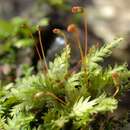Comprehensive Description
provided by North American Flora
Fissidens bryoides Hedw. Sp Muse. 153. 1801
Fissidens synoicus Sull. Musci U. S. 103. 1856. Fissidens inconstans Schimp. Syn. ed. 2. 114. 1876.
Stems 5-25 mm. high; leaves few to many pairs, oblong, rather abruptly short-acuminate in typical forms, in others more obtuse and apiculate, the upper and perichaetial 1.5-2 mm. long, the border strong (especially on the vaginant laminae), typically confluent with the costa at the leaf-apex but often vanishing slightly below it, the vaginant laminae half the length of the leaf; leaf-cells variable in size and shape, mostly irregularly hexagonal, 8-12 /z, sometimes bulging; autoicous; cT buds in the lower leaf-axils; capsule typically erect and symmetric, sometimes inclined, the median exothecial cells mostly oblong with very thick longitudinal walls; spores in winter.
Type i^ocauty: Germany.
Distribution: Mostly on moist soil; Canada and the U. S. east of the Rockies, south to the Gulf; Vancouver I.; on limestone, in Deering Hammock near Miami, Fla.; Puerto Rico {Steere 6052, 6058, 5657); also in Europe.
I1.LUSTRAT10NS : Bryol. Eur. (17:) pi. 101 (as F. exilis); Braithw. Brit. Moss-Fl. 1: pi, 10, E.
- bibliographic citation
- Robert Statham Williams. 1943. (BRYALES); DICRANACEAE, LEUCOBRYACEAE. North American flora. vol 15(3). New York Botanical Garden, New York, NY

